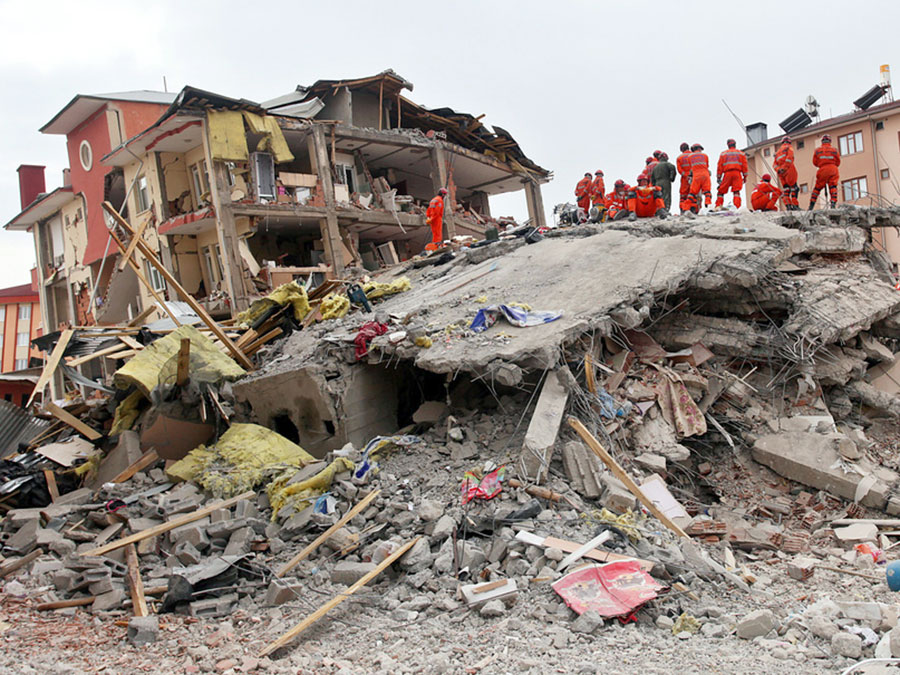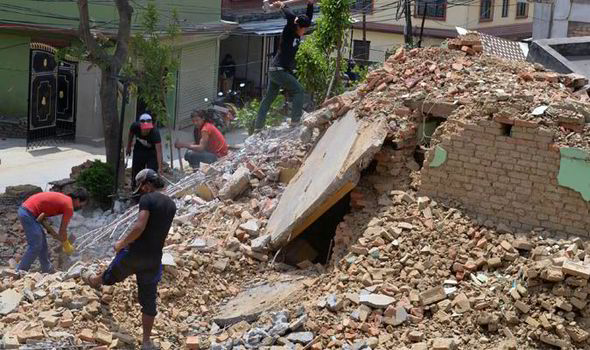The US Geological Survey describes an earthquake as “the ground shaking caused by a sudden slip on a fault. Stresses in the earth’s outer layer push the sides of the fault together. Stress builds up and the rocks slip suddenly, releasing energy in waves that travel through the earth’s crust and cause the shaking that we feel during an earthquake.”
In simple words, Earthquake, any sudden shaking of the ground caused by the passage of seismic waves through Earth’s rocks. Seismic waves are produced when some form of energy stored in Earth’s crust is suddenly released, usually when masses of rock straining against one another suddenly fracture and “slip.”
Earthquakes occur most often along geologic faults, narrow zones where rock masses move in relation to one another. The major fault lines of the world are located at the fringes of the huge tectonic plates that make up Earth’s crust.
About 50,000 earthquakes large enough to be noticed without the aid of instruments occur annually over the entire Earth. Of these, approximately 100 are of sufficient size to produce substantial damage if their centers are near areas of habitation. Very great earthquakes occur on average about once per year. Over the centuries they have been responsible for millions of deaths and an incalculable amount of damage to property.

Where do earthquakes happen?
Earthquakes usually occur on the edges of large sections of the Earth’s crust called tectonic plates. These plates slowly move over a long period of time. Sometimes the edges, which are called fault lines, can get stuck, but the plates keep moving. Pressure slowly starts to build up to where the edges are stuck and, once the pressure gets strong enough, the plates will suddenly move to cause an earthquake.
Foreshocks and Aftershocks

Generally, before and after a large earthquake, there will be smaller earthquakes. The ones that happen before are called foreshocks. The ones that happen after are called aftershocks. Scientists don’t really know if an earthquake is a foreshock until the bigger earthquake occurs.
Fun Facts about Earthquakes
- The earliest reported earthquake in California was felt in 1769 by the exploring expedition of Gaspar de Portola while the group was camping about 48 kilometers (30 miles) southeast of Los Angeles.
- The largest earthquake ever recorded in the world was in Chile in 1960. It measured a 9.6 on the Richter Scale.
- The largest in the US was a 9.2 magnitude in Alaska on March 28, 1964.
- They can cause huge waves in the ocean called tsunamis.
- Earthquakes can happen in any kind of weather.
- Alaska is the most earthquake-prone state and one of the most seismically active regions in the world. The region experiences a magnitude 7.0 earthquake almost every year and a magnitude 8.0 or greater earthquake approximately once every 14 years.
- The National Earthquake Information Center (NEIC) records an average of 20,000 earthquakes every year (about 50 a day) around the world. There are, however, millions of earthquakes estimated to occur every year that are too weak to be recorded.
- An undersea earthquake in the Indian Ocean triggered a series of devastating tsunamis on Dec. 26, 2004. The tsunamis struck the coasts of most landmasses bordering the Indian Ocean, bringing 100-foot waves and killing over 225,000 people in 11 countries.
- The hypocenter of an earthquake is the location beneath the earth’s surface where the rupture of the fault begins.

- The magnitude of an earthquake is a measured value of the earthquake size. The magnitude is the same no matter where you are, or how strong or weak the shaking was in various locations. The intensity of an earthquake is a measure of the shaking created by the earthquake, and this value does vary with location.
- From 1975-1995 there were only four states that did not have any earthquakes. They were: Florida, Iowa, North Dakota, and Wisconsin.
- The damage caused by earthquakes also depends on their depth and fault type.
- It is important in earthquake-prone countries such as Japan to build houses and buildings that react well to earthquakes. Good engineering practices can help stop buildings collapsing under the stress of large earthquakes.
- Seismometers are used to measure the magnitude of earthquakes. You are unlikely to feel a magnitude 3 earthquake but a magnitude 6 earthquake could potentially cause large damage.
- Oil extraction can cause minor earthquakes. These are not the quakes you read about. Rather, because oil generally is found in soft and squishy sediment, when oil is removed other rock moves in to fill the void, creating “mini-seismic events” that are not noticeable to humans.
- Moonquakes (“earthquakes” on the moon) do occur, but they happen less frequently and have smaller magnitudes than earthquakes on the Earth. It appears they are related to the tidal stresses associated with the varying distance between the Earth and Moon. They also occur at great depth, about halfway between the surface and the center of the moon.

- Quakes on one side of Earth can shake the other side.
- The deadliest earthquake ever struck January 23, 1556 in Shansi, China. Some 830,000 are estimated to have died.
- They can permanently alter the map. A powerful earthquake, like the one in Haiti, can “render current maps out of date, posing additional challenges to rescue workers on the ground,” Science Daily explains. “New satellite images can help rescue efforts by providing updated views of how the landscape has been affected.”
- The longest recorded earthquake lasted for 10 minutes whereas an average earthquake lasts around a minute.
- Japan’s massive 2011 earthquake shifted the earth’s mass toward the center, causing the planet to spin faster and shortening the day by 1.6 microseconds. The 2004 Sumatra quake shorted the day by 6.8 microseconds.
Most Earthquake-prone countries
There are many countries that experience earthquakes on a fairly regular basis. The largest ever recorded took place in Chile, near Valdivia.
In Japan, there are at least 1500 earthquakes per year, which makes out to about 2-3 per day. Luckily, most of them are smaller. Below are some of the countries that are most prone to earthquakes in the world!
- Japan
- Nepal
- India
- Ecuador
- Philippines
- Pakistan
- El Salvador
- Mexico
- Turkey
- Indonesia
How to stay safe during earthquakes

Follow these safety tips if a quake is happening:
- Drop down, take cover and take cover under a table or desk.
- Protect yourself with pillows or mattresses.
- Stay away from furniture that can fall down.
- Stay away from windows.
- If you’re outdoors, stay away from buildings, powerlines or trees.
- If you’re driving, slow down your speed at stay when you’re in a clear area.



